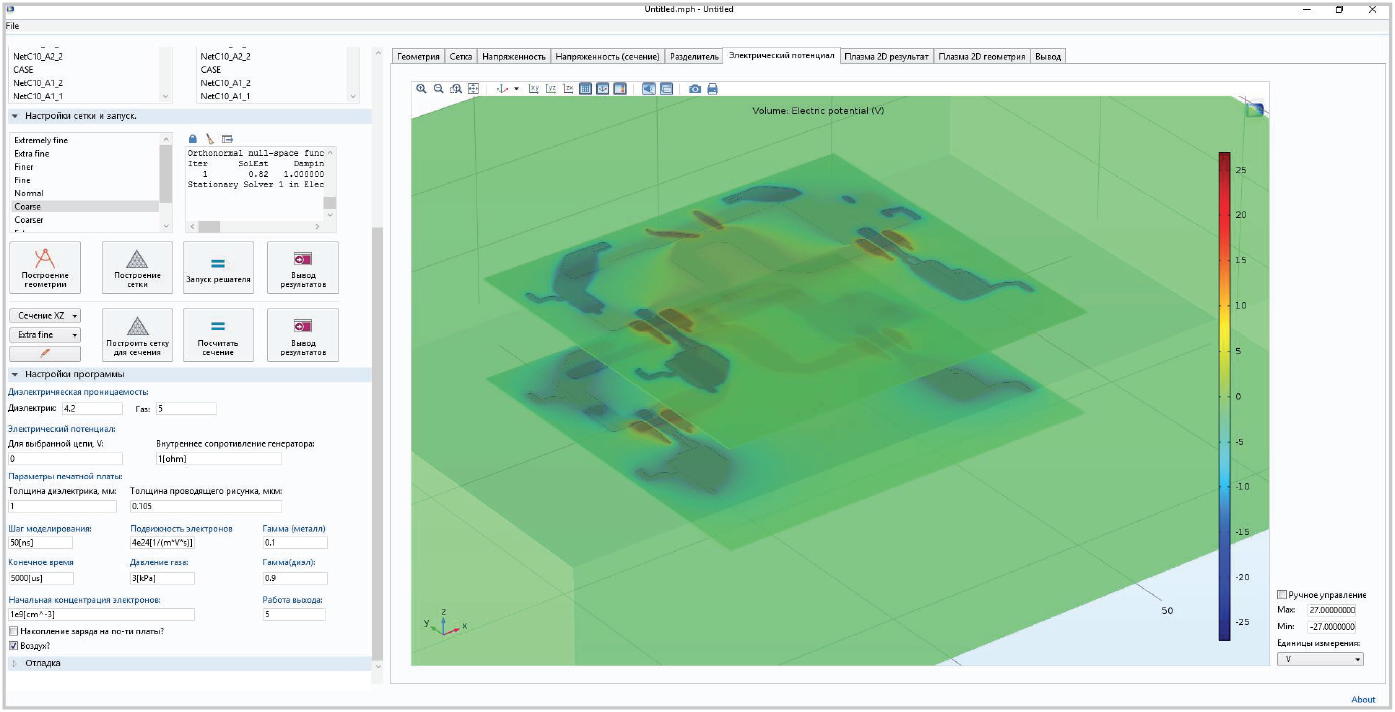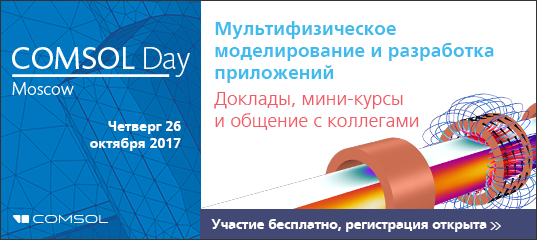Determination of the electric arc in the electronics of satellite systems
The occurrence of an electric arc discharge on orbital satellites is difficult to predict and often leads to system failure. Engineers at the Institute of High-Current Electronics (Tomsk, Russia) use COMSOL Multiphysics ® multiphysical software to detect critical areas of breakdown, as well as to optimize the protection of onboard equipment.

Fig.1. Typical damage caused by the primary arc in a power source operating
at a voltage of 100 V.
In 1995, Boeing Satellite Systems introduced a new family of interface buses for satellites with power, control and propulsion systems in one package. The satellites used high-voltage buses connected to a stabilized power source of 100 V instead of the standard voltage of 27 V. This resulted in an increase in the operating voltage, which reduced the operating currents and the corresponding active losses in the conductors. However, this also created the danger of a catastrophic accident in the electronic systems of satellites — the arc discharge (Fig. 1).
The transition to a new standard of operating voltages led to the problem of the emergence of an electric arc between elements of electronic printed circuit boards. In order to minimize the mass of the satellite, the space inside the board is not filled with an insulator and is not designed to work in a vacuum. This may cause an electric arc discharge or discharge stage, which can spread to a significant amount of onboard equipment. Ignition of the electric arc inside the on-board satellite system always leads to partial or complete failure. In most cases, this leads to satellite failure.
Vasily Kozhevnikov, a researcher at the Institute of High-Current Electronics, explains:
“Our research is closely related to the physics of a gas discharge under extreme conditions, under which electrical equipment does not always work according to ordinary physical laws. For example, electrical discharges sometimes occur below the threshold, known as the minimum Paschen voltage. Under normal conditions, such voltage values are insufficient for the occurrence of a discharge or an electric arc between two electrodes. We believe that this study will also find potential application for the diagnosis of electronics, operating in a wide range of external parameters, such as pressure, ionization levels, etc. ”.
Since electronic systems are used in more and more extreme conditions, the problem of preventing an electric arc is relevant not only for the civil space industry. An electric arc is a threat to any electronic product designed for long battery life with increased requirements for fault tolerance. Therefore, the solution to this problem is relevant not only for satellites, but also for ground systems and underwater equipment.
Defining critical areas
To prevent the destruction of the onboard electronic device by spontaneous arc discharge, it is necessary to designate the so-called “critical region” in which a self-sustaining discharge occurs. Once this potentially problematic area has been identified, engineers should conduct additional research to identify the causes that may cause an electric arc.
“In COMSOL software, we were able to conduct research without creating our own computational code. We expect that [it] will be extremely promising for our future research ”- Vasily Y. Kozhevnikov, a researcher at the Institute of High-Current Electronics.
In the course of experimental studies, it is impossible to determine such risk zones, since in practice it is impossible to reproduce the entire range of operating parameters possible in space orbit.

Fig. 2. An example of a printed circuit board for satellite equipment. Width of critical areas less than 5 mm. Engineers at the Institute of High Current Electronics need to determine the range of unsafe operating conditions and characteristics to design a system that can be operated onboard satellites without the risk of failure.
The only possible alternative, modeling, is also fraught with difficulties. First of all, a typical on-board electronic device consists of a set of printed circuit boards, distributed over a large area and placed inside a metal case (Fig. 2).
“The only way to determine the possible areas of a self-sustaining discharge is a numerical simulation of the discharge, but it is almost impossible for such large-scale tasks because of the associated computational costs. The task of modeling the discharge is both multiphysical and multilevel ”- Vasily Y. Kozhevnikov, a researcher at the Institute of High-Current Electronics.
Processing a geometric model
The research team in Tomsk has been working hard to find an accurate and practically applicable computational approach. To solve this problem, the researchers proposed a “decomposition” methodology implemented using computational tools. Instead of a full simulation of the DC discharge for the entire electronic device, they created a specialized simulation application that independently divides the device into parts and searches for the most likely critical areas in it. To this end, they used COMSOL Multiphysics software and an application development environment to create a multiphysical model that supports the entire simulation cycle.

Fig. 3. Correction of geometry in COMSOL.
An important stage of the simulation was the pretreatment performed to apply the proper boundary conditions and import the detailed geometry of the real on-board electronic system.
Short video review (in Russian): right here
The video describes the main tools for working with geometry, import and processing operations of third-party CAD geometries, and demonstrate the construction of a geometric model using COMSOL Multiphysics ® .
Using the Application Development Environment, the team pre-processed using a special method based on a three-dimensional macro model. They also implemented their own import mechanism with automatic correction of object borders (Fig. 3). This made it possible to significantly simplify the process and improve the grid generation result (by reducing the number of computational nodes), as well as increase the calculation speed, reducing the computational complexity of the task.
Short video review (in Russian): right here
The functionality of the Application Development Environment for setting up a graphical interface of applications for modeling and writing custom functions and macros was demonstrated.
Task decomposition - plasma physics
After preliminary processing, the simulation was carried out in three stages:
- Preliminary electrostatic analysis of potential critical areas in a three-dimensional model
- Extraction of areas in which the field amplification process takes place, and determination of critical areas using appropriate two-dimensional models
- Simulation of DC discharge in critical areas for further investigation.

Fig. 4. Left: electron density distribution for the self-sustaining discharge phase. This two-dimensional model was obtained on the basis of the results of determining critical regions in a three-dimensional model of a satellite power source. Right: an example of a critical parameter diagram showing the dependence of electron emission on pressure. The color map shows the level of the discharge current density.
From the very beginning, the team used the COMSOL Multiphysics ® software package because of its unique functionality in the Plasma module , which allows, among other things, to conduct research based on a two-stage theoretical model of direct current discharge, changing the necessary parameters. In the simulation, an analysis of the electron density distribution was carried out and a critical region was identified (Fig. 4).
Kozhevnikov explains: “The COMSOL Multiphysics ® software package exactly meets the requirements of our project, in particular, in the field of analysis of the working pressure range. Such a calculation for medium and high pressures (based on the finite element method ) is much faster and more convenient than particle-to-cell modeling (PIC) . The PIC method is simply inappropriate for such tasks due to high computational costs. It is possible to simulate only simplified configurations (for example, gas diodes), but, depending on the task, it may take 5–20 times longer for medium pressures than calculations using COMSOL. The average calculation time in COMSOL for such a configuration is less than 2 hours. "
The group-created specialized application shown in Figure 5 allows you to hide from the user the most complex elements of the model, in particular, the original equations and the complex description of the physical phenomena in question in the software interface, leaving the intuitive elements of a customizable graphical interface allowing you to edit the necessary parameters and launch custom commands and process results.

Fig. 5. The multiphysical application developed by V. Kozhevnikov and his colleagues allows changing such parameters as pressure and emission of electrons to determine the areas in which the self-sustaining discharge is most likely. The application allows you to change the position of the arc and explore some of the modes of ignition of the discharge without full-scale modeling of the DC discharge. As a result of the work, it calculates the electric potential in the entire system of electronic components.
Kozhevnikov says: “Strictly speaking, thanks to COMSOL, we were able to conduct research without creating our own computational code, which would be extremely difficult for this task. We expect this software to be extremely useful for our future gas discharge research. The argument for choosing COMSOL was also a wide range of preprocessing and post-processing tools, including the Application Development Environment and import functions from various CAD systems . ”
Aerospace and interdisciplinary solutions
According to researchers, it is possible to use similar models in research in which other practical problems are solved. If complete non-destructive testing becomes possible in the future, modeling in COMSOL will narrow the scope of experimental testing by eliminating non-essential parts. Some work on the development of non-destructive tests were performed by colleagues V.Kozhevnikov from the laboratory of vacuum electronics of the Institute of High-Current Electronics.
“The autonomous software for satellite equipment must be flexible enough to guarantee the constant operation of the device,” V. Kozhevnikov notes. - The standards of the space industry change periodically, so it is difficult to take into account all the consequences of such changes. We solved the problem of diagnostics of the arc discharge, however, we expect that the increase in voltage will also require a serious modernization of some onboard electronic devices to meet the new operating conditions. Simply put, if the operating conditions of any device are significantly different from the "normal conditions", then its architecture must be rebuilt accordingly. Our application provides recommendations for redesigning printed circuit boards to increase their resistance to an electric arc, but it can also be useful in the development of fault-tolerant electronic systems. ”
PS Additional Information
The article is based on the materials of the magazine COMSOL NEWS 2017 . The presentation of the results of this work took place:
- At IEEE Mediterranean Electrotechnical Conference 2016 (Cyprus): an article on IEEE
- At the conference of users of COMSOL Conference 2016 (Germany): a detailed description and presentation (in English)
- At the bottom of COMSOL 2016 in Skolkovo (Russia): video of performance (in Russian)
Additional information on the formulation of the problem and the processes under study in plasma: a report on research and development “Conducting problem-oriented research to develop methods for identifying mechanisms for the occurrence of arc discharges in onboard equipment of spacecraft during long-term operation in space conditions and developing recommendations for their prevention . ”
Video demonstration of the work developed by the authors of the application:
It was made for the competition Create the Future 2016 .
Within this blog, we, the Russian office of COMSOL, will continue to acquaint you with various examples and techniques for using COMSOL for interdisciplinary modeling. Stay with us and come on October 26 for the next day COMSOL 2017 in Moscow, where you can see the actual presentations of users and master classes live.
')
Source: https://habr.com/ru/post/373863/
All Articles
